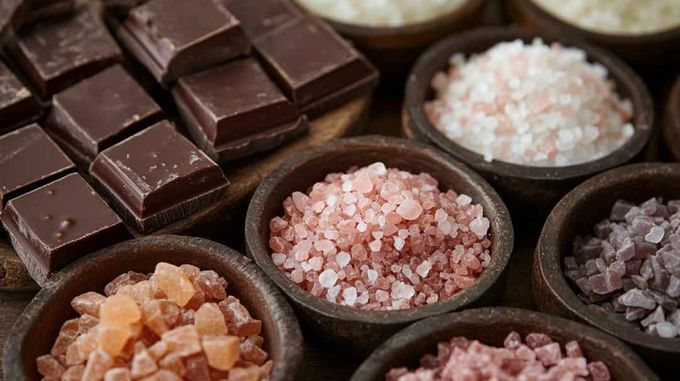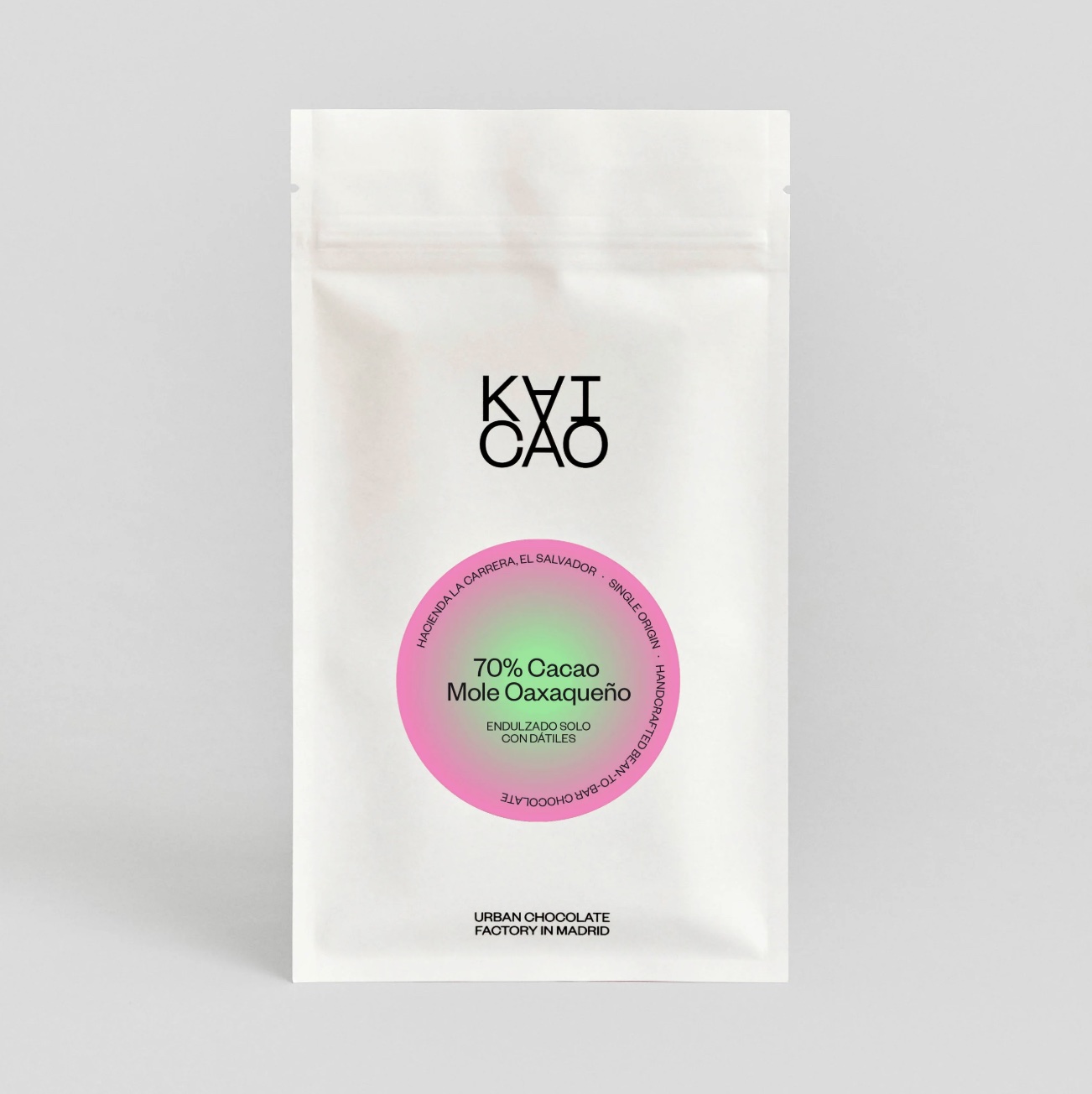Why Salt Enhances the Flavor of Chocolate: A Culinary Exploration
Discover how salt can elevate chocolate to new heights, revealing hidden depths of flavor and complexity you never knew existed
Published January 31, 2025

Have you ever wondered why a sprinkle of salt makes chocolate taste even better? Although the combination of salt and chocolate might seem counterintuitive at first glance, it has been captivating palates across cultures for generations.
From traditional Mexican mole to modern artisanal chocolate bars, salt has proven itself as more than just a seasoning—it transforms the chocolate experience into something extraordinary.
» Discover the perfect balance of sweet and salty with KAICAO
This history of salt and chocolate
Before artisanal chocolate makers started sprinkling flaky sea salt on their bars, ancient civilizations understood the power of combining salt with cacao.
In Mexico, the birthplace of chocolate, salt has been an essential ingredient in traditional recipes like mole, a complex sauce that marries chocolate with spices and savory elements. This wasn't just about flavor preferences—these ancient cultures understood the powerful interaction between salt and chocolate.
The tradition of combining salt and chocolate has evolved differently across cultures. In pre-Columbian Mesoamerica, cacao drinks often included both salt and chili, creating a complex flavor profile that bore little resemblance to today's sweet chocolate treats.
As chocolate spread to Europe and became the sweeter confection we know today, salt temporarily replaced sugar. However, the modern craft chocolate movement has rediscovered this pairing, bringing salt back to its rightful place in chocolate making.
Why salt makes chocolate better
When salt meets chocolate on your tongue, something remarkable happens. It's not just about adding a salty taste – it's about transforming the entire chocolate experience. The science behind this enhancement is both complex and fascinating.
Here are the key ways salt works its magic on chocolate:
- Sweetness enhancement: When salt crystals dissolve on your tongue, they trigger specific neural pathways that amplify your sensitivity to sweet flavors. This means you experience more sweetness without adding sugar, allowing the chocolate's natural flavors to shine more intensely.
- Reduced bitterness: By suppressing harsh, bitter notes, especially in dark chocolate, salt allows the subtle fruit and floral characteristics of the cacao to emerge. These delicate flavor notes, often masked by bitterness, become distinctly noticeable and add complexity to the tasting experience.
- Enhanced Flavor Distribution: Salt stimulates saliva, which helps dissolve and distribute chocolate's flavor compounds more effectively across your palate. This improved distribution means you experience the full spectrum of flavors more quickly and thoroughly.
- Flavor Bridging: Whether combining nuts, spices, or fruits with chocolate, salt helps create a seamless flavor experience in which each ingredient contributes to a unified whole rather than competing for attention. This is particularly important in craft chocolate, where multiple flavor notes need to work together.
» Explore the art of premium bean-to-bar chocolate
The chemistry of taste
At a molecular level, salt affects how our taste buds perceive various flavor compounds in chocolate. Chocolate contains hundreds of chemical compounds, each contributing to its complex flavor profile. These include:
- Theobromine and caffeine, which contribute to chocolate's characteristic bitterness
- Various polyphenols create astringent and complex flavor notes
- Fatty acids that provide richness and mouthfeel
- Pyrazines and other aromatic compounds that give chocolate its distinctive aroma
When added to chocolate, salt actively influences how we perceive each compound. Salt ions interact with our taste receptor cells, modifying their response to other flavors. This is why properly salted chocolate doesn't taste salty—instead, it tastes more intensely chocolatey.
» Craving something different? Try dukkah and salt chocolate
Choosing the perfect salt crystal
The type of salt used in chocolate can significantly affect the final taste experience. Professional chocolatiers carefully select specific salts based on their unique properties and how they interact with chocolate. Here are some of the most popular choices:
Fleur de sel
Fleur de sel stands as the gold standard for chocolate pairing. These delicate, hand-harvested sea salt crystals from France contain trace minerals that add subtle complexity to the chocolate. Their unique crystal structure creates tiny bursts of salinity that enhance the chocolate's flavor without overwhelming it, making them perfect for high-end confections.
» Experience the exquisite taste of dates, chocolate, and Fleur de sel
Maldon sea salt
Maldon sea salt has gained popularity among chocolate makers for its distinctive pyramid-shaped crystals. These large, crunchy flakes provide an exciting textural contrast and controlled release of saltiness, making each bite a unique experience. The salt's clean taste and pleasant crunch make it an excellent choice for chocolate bars and truffles.
Himalayan pink salt
Himalayan pink salt brings both visual appeal and mineral complexity to chocolate. Its rosy hue adds beauty to finished products, while its rich mineral content contributes subtle flavor nuances that can particularly complement the complex taste profiles of single-origin chocolates.
Preferred methods for salt incorporation
Professional chocolate makers have developed sophisticated techniques for incorporating salt into their creations. The amount typically ranges from 0.1% to 0.5% by weight of chocolate—just enough to enhance flavor without overwhelming the palate.
The timing of salt application
Adding salt during chocolate making presents challenges. Salt's abrasive nature can hinder particle refinement, creating a gritty texture. It can also alter the chocolate's viscosity, affecting flow and setting.
Moreover, heat and friction can break down salt differently, producing a uniform but potentially less interesting flavor than if salt were added later.
That's why most professional chocolatiers prefer to either:
- Add salt to ganaches or fillings where moisture is already present
- Sprinkle it on the surface just before setting
- Use it in compound coatings where tempering isn't required
This approach maintains the optimal crystal structure of the chocolate and provides delightful bursts of saltiness that enhance the eating experience.
» Explore the complexities of tempering chocolate
Elevating chocolate through salt with KAICAO
At KAICAO, we've mastered the art of salt and chocolate. Our expertly crafted bars showcase the transformative power of salt, elevating the chocolate experience to new heights.
75% Dark Chocolate with Dukkah
The Dukkah chocolate bar demonstrates our commitment to pushing flavor boundaries. Unlike our other products, which use salt as a finishing touch, this bar incorporates Mediterranean sea salt directly into the spice and nut mixture.
The result is one of our most distinctive offerings, in which salt harmoniously complements the spices to create a unique savory-sweet profile.
70% Dark Chocolate With Mole Oaxaqueño
Our Mole Bar represents our most complex creation, drawing inspiration from traditional Mexican mole recipes. While traditional mole can contain over a hundred ingredients, we've carefully distilled its essence into a chocolate bar that delivers a sophisticated tasting experience.
The addition of hand-selected fleur de sel helps unveil layers of flavor, from initial spice notes to creamy sesame undertones, concluding with a gentle chile heat that lingers on the palate.
37% Camel Milk and Cacao Fruit Bar
Our camel milk chocolate showcases how salt can transform white chocolate into something extraordinary. We use Maldon sea salt to balance the natural sweetness of camel milk, creating a sophisticated flavor profile that has become one of our most popular offerings.
» Discover functional foods that nourish your body and mind
Is salted chocolate healthy?
For those concerned about sodium intake, it's worth noting that the amount of salt used in chocolate is typically minimal. The salt content in a standard 70-gram chocolate bar usually represents less than 1% of the total composition.
This small quantity can enhance flavor without significantly impacting the product's nutritional profile or interfering with chocolate's beneficial compounds, such as flavonoids and antioxidants.
The presence of salt can actually help slow the melting of chocolate in your mouth, prolonging the release of beneficial compounds and creating a more mindful eating experience.
» Want the health benefits of cacao? Discover why ritual cacao is the answer
Where salt meets chocolate, magic happens
The future of chocolate-making lies at the intersection of tradition and innovation, where ancient wisdom meets modern understanding. As we continue to unlock the secrets of how salt enhances our perception of flavor, chocolate makers are discovering new ways to create more complex and satisfying taste experiences.
At KAICAO, we've mastered the delicate balance of salt and chocolate. From the complex spice notes of our Dukkah bar to the subtle sophistication of our 70% Dark Chocolate with Mole Oaxaqueño, we use salt to elevate chocolate from a simple sweet to an extraordinary sensory experience.
KAICAO invites you to experience chocolate as it should be: complex, engaging, and mindfully crafted.
» Indulge in the magic of salt and chocolate with KAICAO
Disclaimer: The chocolate information provided by Kaicao is intended for educational purposes related to chocolate products. We encourage you to embrace the chocolate experience, savor each moment, and explore the world of chocolate with passion.


